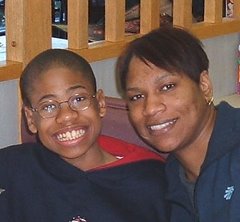Public release date: 5-Jul-2005
Contact: John Ascenzi
Ascenzi@email.chop.edu
267-426-6055
Children's Hospital of Philadelphia
Classification tool may better describe autism-related disorders, help evaluate treatments
A new classification tool may allow healthcare professionals treating children with autism and autism-related disorders to more systematically sort out the combination of traits in the condition, and to better predict how children may improve over time. If the model holds up to further study, it may also allow researchers to gauge the effectiveness of different autism treatments.
Developmental pediatrician James Coplan, M.D., reports on a study of 91 children he saw between 1997 and 2002 at the Regional Autism Center of The Children's Hospital of Philadelphia. Most patients were pre-schoolers or of elementary school age, and predominantly boys. The study appears in the July 2005 issue of Pediatrics.
The children in the study had autistic spectrum disorders (ASD), a group of neurodevelopmental disorders of impaired social communication. Those disorders include classic autism, pervasive developmental disorder and Asperger's syndrome. Dr. Coplan studied the relationship among three variables: the severity of the disorder (called atypicality), general intelligence (measured as IQ or developmental quotient) and time.
"These disorders are dynamic and change over time," says Dr. Coplan. "Although they are traditionally classified into mutually exclusive diagnostic boxes, they tend to blend into each other, and this model provides a way to look continuously at ASD, as the symptoms occur and develop along the autistic spectrum, and as the symptoms change over time."
Some children have severe autistic symptoms but high intelligence; others have mild symptoms and mental retardation, or combinations in between, he added. In explaining the model to parents, he sometimes draws an analogy to weight and height. Just as each individual can have a different combination of weight and stature, someone can have an individual combination of intelligence and degree of autism.
One central finding of the study, said Dr. Coplan, is that children in the normal range of intelligence (an IQ of 70 or above) show significant improvement in their ASD symptoms over time. "We can offer the hopeful message to parents that many children with ASD will improve as part of the natural course of the condition," he said. This finding reinforced impressions by Dr. Coplan and many previous researchers about clinical outcomes for children with ASD.
Dr. Coplan cautions that although the model has predictive value for clinical outcomes when looking at average outcomes for groups of children, it will not necessarily predict a course for each individual patient. Rather it would provide a "roadmap" on which to plot a child's progress over time.
The model still must be confirmed in larger studies of populations of children with ASD, not just in a sample from one clinic, according to Dr. Coplan.
If larger studies validate the model, he adds, it may become a benchmark to help researchers evaluate the effectiveness of particular ASD treatments. "Many currently popular therapies may be capitalizing on the natural history of ASD, and claiming such improvement on their own behalf," he writes in the paper. If patients improved more than would be anticipated from the model's outline of the natural course of ASD alone, that might provide evidence for a treatment's success.
Additionally, the model might shed light into causes of ASD, as yet unknown. Children with ASD from different causes may follow different developmental paths," says Dr. Coplan, and studying those patterns may help researchers to better identify causes for the diseases.
Dr. Coplan has since left Children's Hospital to establish a private practice, Neurodevelopmental Pediatrics of the Main Line, in Rosemont, Pa. Dr. Coplan's co-author was Abbas F. Jawad, Ph.D., of the Division of Biostatistics and Epidemiology of The Children's Hospital of Philadelphia, and the University of Pennsylvania School of Medicine. The Regional Autism Center at Children's Hospital houses a large interdisciplinary program for the diagnosis and treatment of children with ASD.
###
About The Children's Hospital of Philadelphia: The Children's Hospital of Philadelphia was founded in 1855 as the nation's first pediatric hospital. Through its long-standing commitment to providing exceptional patient care, training new generations of pediatric healthcare professionals and pioneering major research initiatives, Children's Hospital has fostered many discoveries that have benefited children worldwide. Its pediatric research program is among the largest in the country, ranking second in National Institutes of Health funding. In addition, its unique family-centered care and public service programs have brought the 430-bed hospital recognition as a leading advocate for children and adolescents.
For more information, visit www.chop.edu.
For more information and resources on autism, go to:
http://www.autismconcepts.com/.
Forget what you haven't heard… Family site shares news, resources, announcements and free or low-cost ways to help us manage day-to-day living with autism.
Crystal Brown

About Me

- Crystal
- AutismConcepts.com and Child-Autism-Parent-Cafe.com share a large collection of useful autism information, resources, and how-to articles written by authors who are touched by autism, offering practical solutions to families. Particularly minority and underserved families and caregivers who may not know what to do or where to go for help.
MJ And Me

Blog Archive
-
▼
2005
(194)
-
▼
July
(28)
- Autism - Cut The Crap
- Boys Take Stand In T-Ball Case
- T-ball victim invited to Oakland A's game
- Scientists Advance Understanding of the Role of a ...
- Study reveals parents' MMR views BBC News
- Study: Children with Autism Have Distinctly Differ...
- Tee-ball coach charged in assault
- Special education goes home
- A Kennedy Fuels Autism Debate
- Free Kids and Teens Printable Coloring Pages
- Study Finds Industrial Pollution Begins in the Womb
- Toxic elements found in infants' cord blood
- Parents use alternative method to treat daughter's...
- Should I Vaccinate My Child?
- GAO Report - Child Welfare: Better Data and Evalua...
- Autism, Mercury and the California Numbers
- Study: Positive touch, the implications for parent...
- The Age of Autism: Both Sides Now
- Number of Autism Cases Declines in Calif.
- What is MTHFR Mutation? - Toward Understanding the...
- Mistrust rises with autism rate
- Autism drug cuts aggression
- Autism, mercury, and politics by Robert Kennedy Jr.
- The Age of Autism: Dismaying 'Times'
- CODEX Threat to Supplement Market
- Vaccine tie to autism gains new supporters
- Study: New model may better predict outcomes for c...
- Study questions extent of autism in the U.S.
-
▼
July
(28)